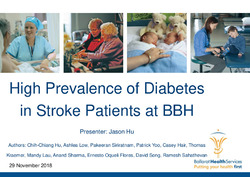Please use this identifier to cite or link to this item:
http://hdl.handle.net/11054/1316| Title: | High prevalence of diabetes in stroke patients at Ballarat Base Hospital. |
| Author: | Sahathevan, Ramesh Hu, Chih-Chiang Low, Ashlea Siriratnam, Pakeeran Yoo, Patrick O'Connor, Ellie Godfrey, Amelia Hair, Casey Kraemer, Thomas Lau, Mandy Song, David Sharma, Anand Oqueli, Ernesto |
| Issue Date: | 2018 |
| Conference Name: | Ballarat Health Services 2018 Annual Research Symposium: research partnerships for population, people and patients; celebrating our research partnerships with the community in the Grampians region |
| Conference Date: | November 29th |
| Conference Place: | Ballarat |
| Abstract: | Diabetes mellitus is an independent and modifiable risk factor for both ischaemic and haemorrhagic stroke. Previous studies have demonstrated a varying prevalence of diabetes in stroke patients, ranging from 17% – 49 %, with higher prevalence observed in Asian populations. The proportion of diabetes in the general population in Australia was 5-6% in the 2014-15 National Survey. The National Diabetes Service Scheme (NDSS) data showed a higher prevalence of diabetes in Ballarat (5.4%) compared to metropolitan Melbourne (3.1%). There is currently no published Australian data on the prevalence of diabetes in stroke populations. Objectives/Aims In this retrospective study, we aimed to determine; i) the prevalence of diabetes for patients with acute strokes and transient ischaemic attacks, ii) the subtype of ischaemic stroke associated with diabetes. We hypothesized that the prevalence of diabetes amongst our stroke patients would be high, a reflection of the proportion of diabetes in regional Victoria. Method We conducted a retrospective audit (Jan 2015 to Dec 2016) of consecutive patients admitted to the Ballarat Base Hospital, with diagnoses of stroke and transient ischaemic attack. We recorded data on stroke type and mechanism, fasting glucose and HbA1c, types of diabetic medications and other cardiovascular risk factors. Results A total of 377 patients were included in our study. The average age for ischaemic stroke patients was 71.74 and 41.5% were female. New or known atrial fibrillation was detected in 34.2%. The prevalence of diabetes in acute ischaemic stroke patients (N=260) in our centre is 27% with one-third of diabetic patients showing poor glycaemic control (HbA1c >8.0). Large artery atherosclerosis appeared to be the predominant mechanism (29.2%) followed by small vessel ischaemia (27.3%). Implications/Outcomes for Planned Research Project The prevalence of diabetes in acute stroke patients admitted to the BHS is worrying, and is almost 3 times the prevalence reported for a developed economy. Our findings suggest that primary and secondary prevention strategies for non-communicable disease and stroke in our population may be inadequate. Final Thoughts The prevalence of diabetes amongst our stroke patients is high. Whether this observation is peculiar to the BHS as a regional centre requires further study. Ideally we would like to compare our number to similar data from other regional and metropolitan populations. |
| URI: | http://hdl.handle.net/11054/1316 |
| Internal ID Number: | 01270 |
| Health Subject: | DIABETES MELLITUS ISCHAEMIC STROKE HAEMORRHAGIC STROKES ATRIAL FIBRILLATION |
| Type: | Conference Presentation |
| Appears in Collections: | Research Output |
Files in This Item:
| File | Description | Size | Format | |
|---|---|---|---|---|
| Jason HU.pdf | ppt | 525.09 kB | Adobe PDF |  View/Open |
Items in DSpace are protected by copyright, with all rights reserved, unless otherwise indicated.
